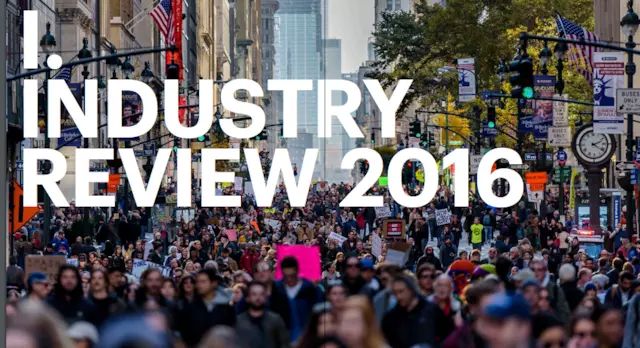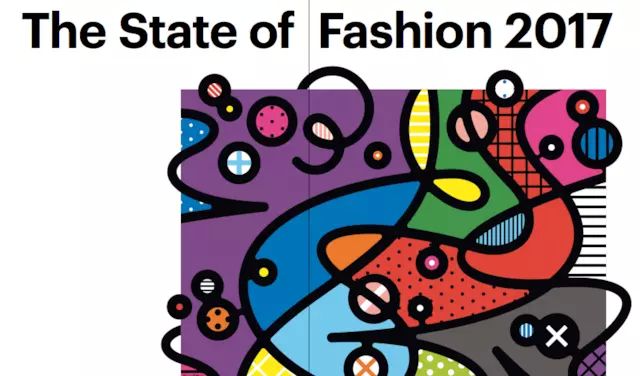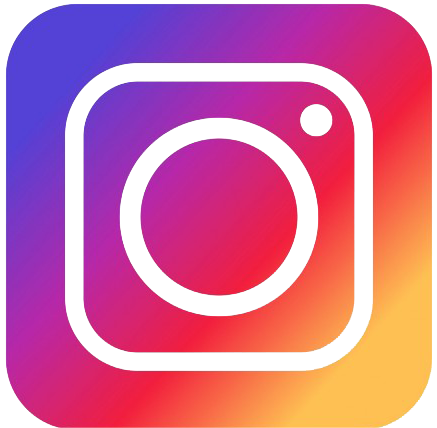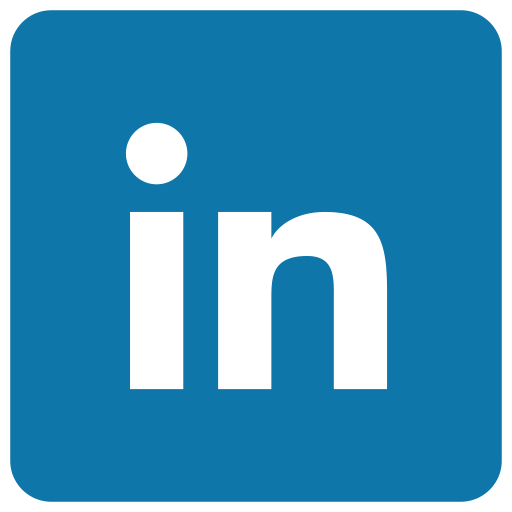Recently, McKinsey released a called The State of Fashion 2017 report (for The Fashion industry, 2017). McKinsey report united the Fashion media BoF to complete together, tracked the Fashion industry valuable sales data, access to Global 1600 CEO of Fashion brand, also released a McKinsey Global Fashion Index (McKinsey Global Fashion Index), one of the most important is from macro to micro summarizes the development regularity of the Fashion industry.

Although called outlook 2017, the 92 - page report also used a lot of ink to the fashion industry in 2016 were summarized. As a result, the report review mainly divided into the fashion industry in 2016 and 2016, the fashion industry looking into two parts, also traces of the interviews with some important figures, such as the Chinese Vogue clothing and beauty editor zhangyu, Arabic version of the editor of Vogue Deena hit Aljuhani Abdulaziz.
Is probably wanted to 2016 and 2017, compare the performance of the fashion industry, the McKinsey analysis of these two years in the fashion industry with similar dimensions, such as the first point often first talk about the present situation of the global political and economic environment, the second a certain talks into the Chinese market and Chinese consumers' impact on the global fashion industry. Then analysis will be referred to science and technology, cost control, sustainability and environmental protection and other issues.
Report covers a total of 20 points, we selected some important but won't repeat itself part of the introduction is as follows. Want to see the original, click here.
In 2016, the fashion industry summarized as follows:
1. The macro political and economic uncertainty
Macro political and economic environment uncertainty is fashion company is worried about a problem. McKinsey interviewed 1600 brands of the world's CEO, they are worried about several problems are: terrorist attacks, the change of China's economic growth is slowing, ec. In addition to the terrorist attacks will affect in some parts of tourism consumption, but also can promote the cross-border electricity trading. According to McKinsey predicts that by 2020, there are about 940 million online consumers spent $1 trillion on cross-border electricity consumption.
2. China's economy slows
This is "the Chinese market is very important in a nice way. In short, since the global economic crisis in 2008, other countries don't have enough spending power is strong, and the Chinese people has been to buy buy buy. As a result, China is an important part of the emerging markets in the fashion industry. But in April, according to the national bureau of statistics, China's GDP growth of 6.7% in the first quarter, and in 2015 the figure was 7.0%, in 2010 the figure was 10%. And China's economic slowdown to fashion companies are worried about the Chinese market consumption ability.
And it is worth mentioning, McKinsey are studied in the rapidly changing Chinese consumers spending habits: first, Chinese consumers are becoming more and more captious on spend money to buy things that; Second, they are willing to spend more money on the service and the experience of lifestyle products.
3. The discount culture rise
Now the consumers not only demand of individuality customized products and services, they also expect the discounted consumption. The north American market is a typical goods discount market. So far, all channels in the north American market in 2016 the clothing sales are 75% discount sales. Some traditional retailers tasted the sweets are beginning to do outlet store, discount store, etc.
And in other markets, such as the discount outlet form is booming in China, will double by 2020. Also in the UK, Germany and other European countries have similar situation. However, discount strategy could bring effect in the short term, but in the long run would damage the brand value, but also not conducive to the development of fashion brands.

4. Changes in consumer habits
Consumer lifestyle continues to evolve, in 2016, mainly for four kinds of forms:
1) because the consumer pursuit of leisure culture, sportswear category is growing rapidly.
2) from the fashion category, gender consciousness is gradually blurred. Zara, for example, gender series was launched in March this year, The department store Selfridges in July has also opened up The Designer Studio new concept retail space, all of The item according to The brand do neither, both male and female, also make a pretense of display.
3) code puts a premium on fashion. Appear on the market the special big yards fashion brand, not just only a few brands increased the category of big yards.
4) in the Muslim world fashion demand, especially consumer demand in the Middle East and South Asia has received the attention. For example, Uniqlo and Dolce & Gabbana are specially made for this product.
Digital upgrade 5.
Consumers can find the promotions and discount product is dependent on the new technology, they are accustomed to buying on the electricity. In addition to the electricity business channel is more and more "important" this topic, the application of VR technology in the fashion industry also count as is digital upgrade. Although, fashion companies tended to be some green -- such as using VR Dior and Tommy Hilfiger VR technology is used in the store to return them in a scene during fashion week.
6. Creativity crisis
There are changes in fashion industry production cycle, such as the emergence of buying or selling mode, namely some brands will be released every year six series of works. This is so for Christian Dior, Lanvin, Calvin Klein and Saint Laurent putting pressure on the brand's creative director. This is not limited to the luxury goods market, the mass consumer market as well. Fast fashion companies in adjusting their pace to adapt to shorter cycle of fashion.
Another change is that the designer can't pushed to market products, need more to listen to retail team feedback to decide the direction of the design.
"In 2016, the market is full of turmoil and uncertainty. McKinsey thinks the market will be 2017 from ease of this turmoil and uncertainty, the market will be 2.5% - 3.5% growth, high-end consumption category (luxury) does not necessarily have what growth."
The outlook for the fashion industry in 2017 has the following a few key points:
1. "uncertainty will be a new normal"
In 2017, McKinsey report or put the macro political and economic environment in the first point to illustrate. And, this analysis of the content and 2016 similar, also mentioned the terrorism, Britain withdrew the political events, but put forward a New idea is "the unrest for the fashion industry will be a New Normal (that's right, use the word is the New Normal)".
2. Still the priority of important Chinese market, but said the market consumption ability in recovery
In the fashion business, the status of Chinese consumers. McKinsey to talk about fashion company ceos think, weakened the market consumption is temporary, because there is a growing number of middle class group, the surging number of mobile phone end consumption. McKinsey argues that, in 2015-2015, the number of the upper middle class in China will account for 28% of the world, and America will only accounted for 3%.
A summary of 3.2016 years, there are no "urbanization" factors
Urbanization is a trend. In emerging markets, with the rapid development of a number of emerging cities are becoming rich, also offering consumers shopping center, make its become central to the development of the fashion for the first time. For example, in the past 30 years, 400 million Chinese moving to cities, they provided new opportunities for the development of fashion companies.
4. Savvy consumers is difficult to predict
In 2017, consumer demand and consumption habits will become more and more complex, also more and more under the influence of science and technology, has become an unprecedented difficult to predict. They become smarter, and more thorough, the relation between each other is more.
This has prompted retailers more to think about how to build the future of the entity shop, how to create consumer experience, how to make use of all channels to create consumer experience, and so on. Brands need to have a global perspective, understand what consumers want, like what, don't like something, like go shopping, shopping and so on. Fashion companies still need to do is, how the segmentation information, to seize the market segment. Sold bucket bag Mansur, famed Gavriel is a good example.
5. The young man's business is important, but also should pay attention to the older consumers
Intergenerational correlation is an important issue. Has two consumer groups are very important, one is always in the millennial generation, the other is the retired elderly group of developed countries. Over the next 15 years, the number of the elderly population will increase a third, increased from 164 million to 222 million. Over the age of 60 to 2025, the global population will account for 30% of the total population in developed countries, accounting for 13% of the population in developing countries. All of these will translate into spending power in the city.
Another important question is, fashion companies should not only focus on to the two groups of age, but their values.
6. Health is indeed a dividend, but now fashion brands do also float to the surface
Consumers now pay more and more attention to fitness, this new way of life for the fashion industry are also new business opportunities, they also launched its own sports leisure production line. Not only that, they also try their best to attract consumers' attention, such as Nike running clubs, Reebok done CrossFit gym and so on.
McKinsey report, however, think that fashion brands now want and consumers together fitness aspect of creativity is very isolated, only superficial. Some brands focus on the story, some brands are using organic fabric design.
"Health should be a person full of senses, and the psychological, physical, emotional, etc. The more a brand can be related to all these aspects, the more you associated with the consumer." The report said.






